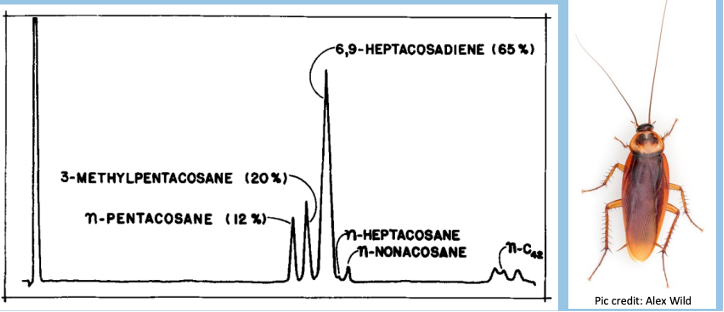|
written by: Darsy Smith and Benjamin P. Gregory How do insects that live in dry environments like deserts keep from drying out, and how might these adaptations help them adjust to our constantly changing world? For our first colloquium of October, the Entomology Department welcomed Dr. Henry Chung, an assistant professor at Michigan State. Dr. Chung’s research investigates the genetic mechanisms underlying insect adaptations to different environmental conditions, particularly dry ones. Just like humans, insects need water to live their lives, so making sure they don’t dry out–or desiccate–is vital to their survival. So how do insects that live in hot and dry conditions prevent desiccation? One of the most important pieces of an insect’s defense against desiccation is its epicuticle, the waxy top layer of its exoskeleton, and the chemical pieces that make up this epicuticle, called cuticular hydrocarbons (CHCs). Cuticular hydrocarbons are long-chains of hydrogen and carbon that serve as waterproofing agents and help insects prevent desiccation. There are a wide variety of CHCs which have different melting temperatures, the property that affects waterproofing ability. CHCs with higher melting points hold more water in, while CHCs with lower melting points are less effective. Different species of insects have cuticles composed of different CHCs, making some species more desiccation resistant than others. You can characterize a species’ CHC profile to get an idea of how desiccation resistant they are, as shown below with the CHC profile of the American Cockroach. In addition to acting as a protective layer, CHCs play an important role in insect communication. If the same chemical building blocks can play two very different roles in an insect's life, this raises a lot of interesting evolutionary questions. For example, what if having the CHCs that make you more resistant to drying out also happen to make it harder for you to communicate? Dr. Chung asked this very question about Australian fruit flies. By knocking out the gene that encodes long, highly desiccation resistant CHCs (mbCHCs), he was able to show that there is a tradeoff between being desiccation-resistant and attractive to mates. In this case, there is somewhat of an evolutionary battle between staying hydrated, and finding love.
However, Dr. Chung’s most recent work has focused more closely on the genetics behind desiccation resistance in Drosophila mojavensis, a fruit fly species that lives in the extremely dry deserts of the Southwest US and Northern Mexico. By comparing the CHC makeup of this species’ cuticle to that of a few other closely related species, he showed that the longer CHCs in its cuticle corresponded with its higher desiccation resistance. Then, he discovered that this species of fly has a gene–which he named mElo–that codes for a specific protein that helps produce these extra long CHCs. By using a procedure called CRISPR/Cas9 knockout, he was able to breed a population of D. mojavensis without a functioning version of mElo, and found that they ended up with far fewer, and far shorter CHCs in their cuticle. It’s clear that this gene is crucial to these desert-dwelling flies’ ability to stay hydrated in the heat. By comparing mElo to similar genes in other insects, Dr. Chung can map out the path of desiccation resistance in many different species, and start to figure out how this group of highly diverse and important animals may adapt to the rapidly changing habitats of the modern world. Due to climate change, weather patterns are shifting all across the globe. Some regions will get wetter, some hotter, and many will get drier. Evolution is a powerful force for change, and learning as much as we can about the underlying complex genetic mechanisms will give us the tools that we need to understand the ecosystems around us. Authors Darsy Smith is a PhD student in the Lamp lab studying host plant resistance and response to natural enemies in alfalfa ecosystems. Benjamin P. Gregory is a PhD student in the Fritz Lab studying how the built environment shapes Culex mosquito evolution. References Baker, G. L., Vroman, H. E., & Padmore, J. (1963). Hydrocarbons of the American cockroach. Biochemical and Biophysical Research Communications, 13(5), 360-365. Chung, H., & Carroll, S. B. (2015). Wax, sex and the origin of species: dual roles of insect cuticular hydrocarbons in adaptation and mating. BioEssays, 37(7), 822-830. Comments are closed.
|
Categories
All
Archives
June 2024
|
Department of Entomology
University of Maryland
4112 Plant Sciences Building
College Park, MD 20742-4454
USA
Telephone: 301.405.3911
Fax: 301.314.9290
University of Maryland
4112 Plant Sciences Building
College Park, MD 20742-4454
USA
Telephone: 301.405.3911
Fax: 301.314.9290


 RSS Feed
RSS Feed




